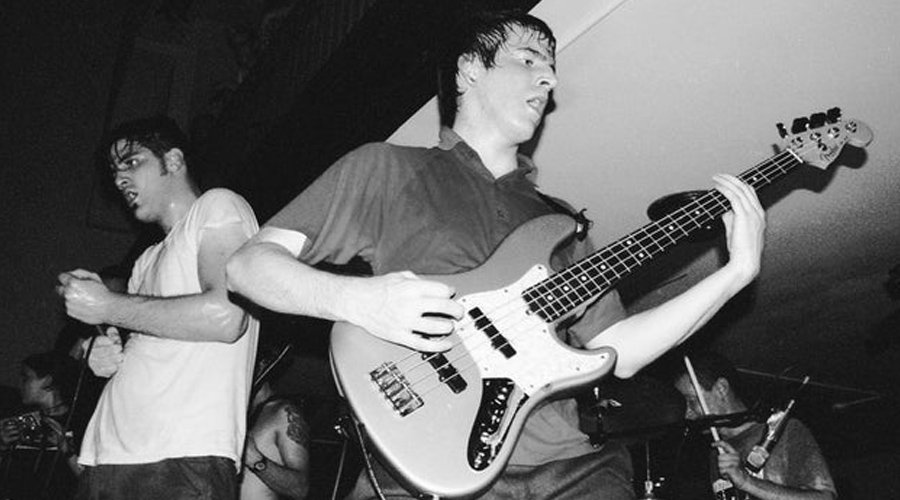Recognised by their unique ability to utilise music’s most chaotic elements, incorporating odd time signatures, dissonant melodies, and irregular rhythmic structures, a dismissal for musical convention has always been the key defining characteristic of mathcore innovators The Dillinger Escape Plan’s sound and ethos. Yet, the band have enjoyed steady and consistent success over their 25-year history, by exploring a range of styles and compositional approaches that have kept their discography from ever growing stale.
Now with the band returning for a number of reunion shows for the summer with OG vocalist Dimitri Minakaki, it only seems right that we dedicate the next EINthology feature to The Dillinger Escape Plan, exploring the band’s six major releases in great depth (along with a handful of their early demos and EPs), honouring their appetite for sonic chaos, experimentation, and excessiveness. But before we explore the rampageous timeline documenting TDEP’s musical history, I’ll provide an overview on the band’s formation and their distinctive DIY philosophy that has assimilated much of their musical and business practices going forward.
Initially formed back in 1996, Dillinger sprouted from more grounded beginnings rooted in the New Jersey metalcore/hardcore scene when founding members Dimitri Minakakis, Ben Weinman, and Chris Penne saw weakness in writing music that fit into a certain formula or ‘theme’ according to guitarist Weinman in an interview with Ultimate Guitar. Unlike their original hardcore sound, Dillinger formed the following year with the ambition of producing sounds that stretched to anarchic levels of musical complexity and absurdity, merging various stylistic elements and sonic themes that acted as a melting pot for ideas. And yet, whilst The Dillinger Escape Plan was formed on the pretence that their style would be one characterised by boundless creativity and the need for pushing sonic limits, the DIY ethos they embraced in these early stages of their career remain throughout with equal importance as the music.
Initially active under the name Arcane, the band later went unnamed for a number of months whilst they played a couple of support slots, firstly with Overcast and secondly with Earth Crisis. It was soon after when friend of the band Matt Makowski would suggest their new name going forward based on a documentary he watched based on the 1930s evasive bank robber John Dillinger, notorious for his escapes from jail. The Dillinger Escape Plan thus was born, and their first musical effort was introduced in the form of a self-titled six track EP in April of 1997.
A departure from the stripped back and simplistic song structures of Arcane, TDEP’s early releases sought to increase their appetite for chaos that was seemingly looming under the surface of their initial hardcore guise. Tracks like “I Love Secret Angels”, “Cleopatra’s Sling”, and “Caffeine” are prime tracks that highlight the band’s early motivations for embracing dissonant musicality and disorderly song structures. The notable “Monticello” features excerpts from the documentary from which the band would be named, before entering a carnal sonic boom of aggressive and powerful riffs; whilst the opening and closing tracks, “Proceed With Caution” and “Three for Flinching (Revenge of the Porno Clowns)” are the absurd layers that contain this EP in all its chaos.
Following from their first original recording, TDEP would commence with live shows and embarking on a tour in the summer of 1997. Throughout the many escapades, the band would prove to have truly embraced their lust for disorder and chaos both on and offstage. Such documented instances of the band’s infamous conduct involved vocalist Dimitri defecating on the sidewalk of a Rochester McDonald’s and hurling it at a disgruntled passer-by; a chaotic performance in which the aforementioned frontman would dive into a table of unsuspecting hippie girls at a Detroit coffee house; and a notably enthralling and violent performance supporting Brutal Truth at the Philadelphia venue Stalag 13 in which saw chairs and guitars being flung around leaving many scars in the aftermath. Furthermore, as interviews would later confirm, Dimitri’s lust for breathing fire would also be a controversial trademark of the band, as did Weinman’s tendency to throw his guitar into the crowd proving to be all the more chaotic and unpredictable as a touring band.
Dillinger would perform with same chaotic energy as recorded and with the release of their second EP Under the Running Board, you can get a glimpse of that volatility. The initial EP consisting of just over a mere seven minutes opens with the minute and a half “The Mullet Burden”. One could argue this is the true beginning of TDEP as a band that sought to push every sonic and performative limit known possible. Followed by the tracks “Sandbox Magician” and “Abe the Cop”, UTRB contains a trademark expression of dissonance and abrasion through Dimitri’s intimidating voice, Pennie’s resemblance of a d-beat style percussion, entwined with complexities that complemented the aggression of John Fulton and Adam Doll’s rhythmic work; and Weinman’s brutish chordal harmonies and melodies that extract dissonance in its purest form.
It’s also key to note the importance of the relationship between Dillinger and would be long-term producer and engineer Steve Evetts for how the band’s sound would take shape and evolve in years to come. Evetts’ work as a metal producer, as well as other genres like emo, hardcore, and pop punk, appeared early on to enhance the experimental approach taken by the artist’s themselves. When taking a look into the early releases of The Dillinger Escape Plan, we can get a feel of Evetts’ raw and direct approach as a sound engineer that allowed the band to successfully mimic the abrasiveness and punkish agility with a distinctive kind of authenticity that had already became a staple of the band’s live performances.
I should also give a mention to a number of splits that Dillinger were involved in around this time, the first being a 3 track split with fellow New Jersey metacore outfit NORA. The sole track by TDEP being an early version of what would be one of the band’s most notoriously chaotic tracks from their first full length release in a few years time titled “4th Grade Dropout”. The second split EP to be released would be with Burlington, Vermont hardcore punk band Drowningman, this time it was an early version of the song “Jim Fear” that would make an appearance. It seemed important to include these releases in the band’s discography overview chiefly because when you were to listen to how the band’s early mathcore/hardcore style was lined up with that of their counterparts in the East Coast hardcore scene, you can get a sense Dillinger took great influence from many of these bands and utilised many excessive sonic characteristics to evolve their sound.
I doubt there has ever been or will ever be a record in the history of heavy music that truly conveys the expression of utter sonic bedlam quite like Calculating Infinity. The volume, complexity, disruption, lawlessness, and complete and utter disregard for the conventional songwriting playbook is off the charts and Dillinger made sure the unsuspecting metal and hardcore community was aware of this. A pioneering debut that, even by today’s standards, challenged the theoretical understandings of musical direction and formulated a new metric to which heavy music is evaluated. Around this time, Dillinger were already established as one of hardcore’s most volatile and violent live bands, they certainly needed to articulate their abrasive persona musically speaking.
Calculating Infinity utilises a number of dissonant and mathematical techniques that demonstrated the band’s initial mathcore sound to which they are renowned for helping establish. The use of diatonic scales being forcefully expressed over a barrage of odd time signatures, irregular rhythmic patterns, and an incomprehensible conveyance of key signatures that make you think is this trying to reach the high artistic realms of free jazz improvisation or, rather, attempting to create a raw breeding ground that defies all musical expectations and replaces such with extremity and controlled chaos. From the commencement of track one “Sugar Coated Sour”, TDEP don’t concern themselves with any introductory activity to set the mood, what we hear is a series of scattered rhythms and melodies notated in an incoherent manner that elucidates disorder. By far an early highlight is the second track “43% Burnt” which feels like a ride of shock waves coursing through the air in the form of dissonant chord stabs and abrupt tempo shifts every few bars.
Dimitri’s vocals on the album unleash sheer intensity with agonising wrath, then you get Weinman and Benoit’s guitars shred out polyphonic neoclassical harmonies to different rhythms and tempos. “Jim Fear” and the appropriately titled “*#..” dish out even more variety that borrows from elements of progressive metal, the jazz fusions of Coltrane, the d-beat grinding of Napalm Death, and even a variety of electronic and synthesisers to create a industrious and dystopian atmosphere.
Yet with all the genre-blending and variations of musical form being implemented in such a violent and unpredictably complex way, it’s somewhat difficult to select just one part of Calculating Infinity as a standout component of this work of genius, however, I do think the rhythmic functions of the record can be realised in their own right as some of the most distinctive and unique to which progressive and extreme forms of music can utter. Chris Pennie’s drumming does not conform to any standard genre-based expectations instead you can listen to the artist mix up sections in the songs like “Destro’s Secret” and “Clip the Apex…Accept Instruction”, going between a jazz swing to furious blast beats.
It is also for many familiar with the early history of The Dillinger Escape Plan that original bassist Adam Doll suffered a spinal fracture during a road accident leading to Weinman taking up bass duties to which he even admitted in a 2013 interview with Ultimate Guitar he had to approach arranging and playing the instrument differently to that of guitar: ‘I certainly realised that during that time a bass player is not just a guitar player that plays with less strings…It was really difficult and it’s one of the hardest things I’ve ever had to do in this band.’

The Dillinger Escape Plan performing at one of their early live shows (courtesy of Grandstand Media)
Of course, the recording of Calculating Infinity, as one could probably tell, had no shortage of challenges that the members of Dillinger faced whilst working on the project early on. Whilst technological and financial limitations were something that many bands faced during the late 90s and early 2000s, to accept these constraints whilst producing music so radically expressive was something that of course increased the ambition and musicianship to conceive an album that each member of the band was happy with. The old school approach to production further saw much of the recording done to tape rather than a reliance on software like ProTools, something that you can certainly hear for instance on the rawness of the title track or “The Running Board” which amplified rough cut audio that signifies the band’s DIY attitude and hardcore tendencies.
For a debuting record, one might even have thought that surely this is as far as things could go as the bar was set rightly high early on for The Dillinger Escape Plan but of course as we will get into later, this was only the start of a discography that was about to break the mould and cause utter carnage on its way.
Of course, the recording of Calculating Infinity, as one could probably tell, had no shortage of challenges that the members of Dillinger faced whilst working on the project early on. Whilst technological and financial limitations were something that many bands faced during the late 90s and early 2000s, to accept these constraints whilst producing music so radically expressive was something that of course increased the ambition and musicianship to conceive an album that each member of the band was happy with. The old school approach to production further saw much of the recording done to tape rather than a reliance on software like ProTools, something that you can certainly hear for instance on the rawness of the title track or “The Running Board” which amplified rough cut audio that signifies the band’s DIY attitude and hardcore tendencies.
For a debuting record, one might even have thought that surely this is as far as things could go as the bar was set rightly high early on for The Dillinger Escape Plan but of course as we will get into later, this was only the start of a discography that was about to break the mould and cause utter carnage on its way.
Whilst Calculating Infinity set the bar relatively high for both TDEP and within the realms of heavy and experimental music in general, Dillinger were ready to demonstrate their consistency and ability to adapt to sudden changes in and around a musical capacity. By the mid 2000s the band had established themselves through their abrasive and chaotic music style and equally volatile live performances touring the likes of Warped Tour and March Metal Meltdown. They would also collaborate with other established artists, most notably with Mike Patton and Mr. Bungle where the band would record the EP Irony Is A Dead Scene, having Patton offer great inspiration and creative input that would help Dillinger expand their musical direction that would explore many experimental stylistic traits and allow the artists to depart somewhat from the mathcore genre label that many had labelled them under.
Around this timeframe Dillinger also faced a number of challenges concerning line up changes. The band would first recruit bassist Jeff Wood to replace Adam Doll who was later replaced by Liam Wilson after the former was committed to other projects. Quite possibly the greatest setback for the band however was the departure of Minakakis, resulting in a nationwide search for a new vocalist. After many auditions, which included Sean Ingram of Coalesce, the band eventually confirmed the recruitment of Greg Puciato in late 2001. With a new chapter unfolding, TDEP we’re ready to demonstrate a new approach to their craft throughout this tumultuous period when they produced their sophomore record, the experimentally significant Miss Machine.
While the record certainly is a departure from Dillinger’s previous work, Miss Machine did allow the band to express their desire for branching out into other styles and sonic characteristics, affirming a discredit to the genre labelling trend that was beginning to emerge for many artists around this time. The record certainly takes things in a whole other direction to Calculating Infinity, yet you can still identify a trademark mathcore sound from first single featuring Puciato on vocals “Baby’s First Coffin”. The wild, excessive, rhythmic complexity retains momentum throughout much of the albums runtime on tracks like “Panasonic Youth”, “Highway Robbery”, and “We Are The Storm”, featuring impenetrable dissonance and jarring sound textures that feel practically textbook for the band.
Running parallel are tracks like “Unretrofied” and “Setting Fire to Sleeping Giants” which break off into far more emotionally charged and melodically enhanced territory. You get a sense of Puciato’s vocal character in more depth here through creepy spoken word lines and Dadaist lyrical interplay it leads the instrumentation and allows some haunting and powerful riffs to shine through, exploring unchartered Nine Inch Nails and Mr. Bungle worship, chaotic jazz fusion, and industrialised soundscapes that envelopes a distinctive balance between complex dissonance and sinister, soundtrack-infused melody.

The Dillinger Escape Plan with Greg Puciato in 2004
With such a sudden change in sound, Miss Machine was not without its critics from longtime TDEP fans. Many spouting a so-called hardcore DIY ethic would discredit the band for the more melody-driven paths that the album explores throwing claims of selling out. This coupled with the attention “Unretrofied” would gain for being featured in the video game WWE Smackdown! vs. Raw 2006, it seemed that The Dillinger Escape Plan were gaining greater attraction from a wider audience due to their willingness to incorporate some more conventional elements to their songwriting. But to claim that Dillinger sold out here would be an injustice to the band’s artistry and craft. What we get from Miss Machine is The Dillinger Escape Plan exercising control over their sound, distancing themselves from being undermined with genre tags and confined to one specific place and time. This somewhat marked the beginning for Dillinger as one of heavy music’s most influential artists in exposing the metal market to more avant-garde leanings and experimentation.
By the mid-2000s, The Dillinger Escape Plan had become a household name amongst both underground and mainstream music and press circles. Their touring cycle consisted of gigs in support of System Of A Down, Megadeth, and Slipknot in what would see the band showcasing their excessive and discordant performative style to a wider range of audiences. Another notable performance that fans might remember either fondly or simply for its notoriety, was during the band’s 2002 performance at Reading Festival in which the band opened on the main stage of the festival in front of some 85-90,000 people when, enraged about having to share a stage with a string of bands he felt were subpar (*cough* Puddle of Mudd *cough*) Greg Puciato defecated into a small bag and launched it into the crowd. For many this was a true act of defiance in which TDEP embodied their need for testing the limits of their craft in the most radically vulgar ways possible, for other onlookers perhaps this was a step too far. Needless to say, the true spirit of chaos and a DIY mentality ran through the band’s veins as they were on top in the rock and metal world.
In 2006, after a string of live performances on the festival circuit and the release of the EP Plagiarism (featuring a radio edit of “Unretrofied” and a series of interesting covers including tracks by Massive Attack and Justin Timberlake respectively), Dillinger were on track to record their third full-length album Ire Works (2007), arguably the band’s most highly acclaimed and well-loved by both critics and fans old and new. This would also see the band face a number of setbacks prior with guitarist Brian Benoit suffering nerve damage in his left hand forcing him to depart the band, as well as drummer Chris Pennie leaving to join Coheed and Cambria which led to the recruitment of Gil Sharone to handle percussion duties.
Needless to say, Ire Works continued to push Dillinger into more creative directions with an outside approach to songwriting. Obtaining many characteristics of Dillinger’s harsher and complex musicality, the opener “Fix Your Face” featuring guest vocals of Dillinger original Dimitri Minakakis feels like a cathartic celebration of dissonance that imbues sections of jazz and metal that teeters on the edge of noise. Another example of collaborative excellence is on “Horse Hunter” supported by Mastodon’s Brent Hinds reinforces the frenzied mathcore in all its extremity. Similar tracks like “Lurch” and “Nong Eye Gong” demonstrate the band’s attachment to their roots through a exhibition of complexity through complex structural sonic design.
The band would further expand on more conventionally structured songs such as “Black Bubblegum” and “Milk Lizard” containing interesting variations on blues, post-hardcore, and neo-classical music as a means of expressing both their rational side to songwriting and their desire to push more experimental boundaries. As bassist Liam Wilson simply regarded, in a 2007 interview with Penny Black Music : ‘The only deliberate vision was to avoid ever painting ourselves into a corner, and whenever possible, either reclaim or break new ground’
Other significant evolutions within the Dillinger sound, which can be heard in Ire Works, is the band’s shift into electronic music territory. “Sick On Sunday” contains exasperated technical glitches being performed in disordered fashion that shapes an apprehensive sonic environment, toyed with the controlled flow of Weinman’s jazz guitar complexities and Sharone’s off-beat style rhythms. Some of these electronic elements find their way into more frenzied and math-styled tracks with subtle variations and atmospheric presence such as on “When Acting Like a Wave” and “Party Smasher”. The use of orchestral instruments like tremolo strings and Asian-infused percussion create an eeriness on “When Acting as a Particle”; dissonant horns and strings help mould the delirious soundscape of “Dead as History”; and the augmented semitonal piano streams a noir-jazz ambience of “Mouth of Ghosts”. Each track adds something new for audiences to appreciate despite shorter run-times of these tracks they imbue enough energy, mystique, and creativity that allows the listener to delve deeper into the complex inner workings of The Dillinger Escape Plan songwriting manual.
With the previous release being somewhat of a turning point for the band both critically for its sonic expansion of ideas and experimentation, and commercially after reaching 142 on the Billboard 200, the Dillinger Escape Plan name was now held in esteem, and they became one of the biggest globally recognised bands by the mid to late 2000s. At this point in time the band would also part ways with their label Relapse Records in favour of their own personal record label Party Smasher Inc. founded by Weinman in 2009 (initially in collaboration with French label Season of Mist) after growing increasingly dissatisfied with the state of the music industry. Certainly, this was showing signs of success and dominance over the heavy music industry with Dillinger demonstrating a willingness to be total masters of their craft not only creatively but also from an economic standpoint as well without the need for a major label backing.
As studio work began for the band’s fourth full length release Option Paralysis, this also would see Gil Sharone depart from percussive duties and be replaced by Billy Rymer as full-time drummer. Recording would take place between September to November 2009 with the band’s longtime collaborator Steve Evetts. And, although being described as a painstaking and overwhelming process by Puciato, a push that the band saw necessary was imbuing the philosophy of hyper-focussing on every little detail and instilling a DIY approach to each sonic application.
Production wise, Option Paralysis is arguably TDEP’s fullest sounding record thus far in their discography rundown. Each track emphasises a greater level of sound quality that doesn’t necessarily translate to being over-polished, rather, the record exhibits a being much more cinematically complex. The opening track “Farewell Mona Lisa” highlights a refinement in the band’s sound, expounding elements of nauseating dissonance through expressive riffs and trademark tempo changes. Similarly, the filling tracks “Good Neighbour” and “Gold Teeth on a Bum” turn between old school Dillinger dissonance and more progressive song structures.
On the more cinematic and instrumentally divisive tracks “Widower” explores elements of lounge jazz and progressive rock that sees an extended minimalistic piano based intro with Puciato’s vocals leading a crescendoing piece to a tantalising performance that showcases a well-blended execution of instrumental virtuosity and minimalistic expression. Also featuring much of these elements with melodic and experimental depth is “Chinese Whispers”, exploring heavier sounds with sweet and catchy guitar riffs that complement Puciato’s vocal lines. Another example of cinematic excellence is the closing track “Parasitic Twins” making use of atmospheric tension and electronic sound design imbued by Weinman to explore a deeper palette of sound exploration utilising various genres and stylistic concepts.
Through a successful transition to Party Smasher, The Dillinger Escape Plan had practically maintained utmost control of their creative output, emerging from the niche corners of the metal world, garnering critical and commercial acclaim, gaining a ‘Golden God Award’ from Revolver in 2010 for Best Underground Band, and embarking on international touring cycles to the likes of Australia, New Zealand, Bangkok, Malaysia, and Columbia. After another departure of guitarist Jeff Tuttle, the band would soon recruit former rhythm guitarist James Love back whilst assuming touring duties. By 2013 it was announced that Dillinger’s next album would titled One of Us Is the Killer.
Considered by many to be Dillinger’s most accessible album, One of Us Is the Killer utilises a range of genres that borrow from some more radio friendly rock formatting yet doesn’t lose sight of the band’s reckless and dissonant sonic identity. The opening track “Prancer” highlights this split between classic TDEP mathcore disorder and the hook-driven, progressive riffs, and song structures that have gradually evolved into being a renowned staple of the band’s sound. Puciato’s vocals express a vehement sense of power and anger that fall back onto Weinman’s aggressive guitar lines.
There is great rhythmic complexity on display here through Rymer’s excellent percussive efforts, tracks like “When I Lost My Bet” encompasses jazz inspired rhythms that create suspense and tension between the dissonant guitar lines, whilst “Nothing’s Funny” implements an offbeat feel centred around tripped up circuitry amongst other elements of sound design. Another notable aspect of this record that gives it a sense of differentiation from other releases in the Dillinger catalogue is the the emphasis of massive choruses. The title track is a great example of hook-like choruses being exhibited with a refined quality, a chilling atmospheric piece borrowing from various jazz, metal, and math rock tropes that crescendos towards a catchy and climatic chorus that allows Greg’s powerfully melodic vocals to shine.

Greg Puciato of The Dillinger Escape Plan performs at the 2013 Revolver Golden Gods Award Show at Club Nokia on Thursday, May 2, 2013 in Los Angeles. (Photo by Chris Pizzello/Invision/AP)
Each song appears to contain their own sense of identity and purpose that only strengthens the overall structure of the album. I particularly would consider some of the tracks near the end of this record like “Crossburner” and “The Threat Posed by Nuclear Weapons” for their flexible use of dynamics and a heavy emphasis on atmosphere and noise. The meticulous process by means of conceiving such individuality within these tracks is certainly decipherable upon multiple listens, however, it should be noted that such a task was not without its barriers in which the artistic merit and labour would be tested by the record’s contributors, particularly for long-time collaborator and producer Steve Evetts. Puciato recalls the pressure put under both the artists and engineer during the recording process revealing the significance of the role of communication through creative labour:
‘Steve almost quit ten times! He was just ready to kill himself, man! He beat us up and then we beat him up. When the recording is done, that’s when he knows he’s about to get back everything he made us do. We make him mix to the brink of absolute exhaustion… Every single time we do a record, I become a better singer, Ben becomes a better guitar player and Steve becomes a better producer’
Another side note I should mention about this album, which makes for a compelling second third, fourth, or 1000th listen, is the fact affirmed by Weinman that much of the tracks also featured many high-profile guest vocalists on different instruments, however, the band themselves have never been allowed to mention them. Puciato sums up in an interview with Thrash Hits:
‘Think in terms of James Hetfield hitting a xylophone, but he’s not one of them. He’s not a xylophone. Xylophones are racists. We can always go back try and guess who these artists are but perhaps the fun lies in the anonymity of these artists that I certainly feel creates a sense of additionally enticement when listening to the record.’
By mid 2015 The Dillinger Escape Plan were practically on top of their game and a dominant force in the metal world, so why were there rumour of extended hiatuses or that the band were generally ready to call it quits? Several line-up changes were always something that tested the band’s longevity (with another rhythm guitarist shake up having Love be replaced by Weinman’s former guitar student Kevin Andreasen), yet this was never enough to stop the band from recording and touring consistently for so long. But when the announcement of the sixth studio album Dissociation surfaced alongside Weinman’s claims that the band would be taking an extended hiatus, only to be followed by Puciato affirming that Dillinger would be breaking up permanently, many were somewhat surprised by the decision whilst others may have understood that it felt natural for the band to end things whilst they were in top form creatively.
Other events, as well as relations between band members also would have taken their toll on everyone involved in TDEP eventually. A tour bus crash during the band’s 2017 farewell tour, for instance, in which the members suffered minor physical injuries and the mental toil would have possibly increased their motivations to leave this aspect of the musician’s life behind. Weinman would even explain to Louder Sound how much of the themes shared on the final recordings of the band had much to do with the ‘tug and pull‘ of himself and Puciato as well as relationships in general. A level of dependency between the two was obvious yet the frustrations of touring and recording would eventually reach a natural tipping point.
With this in mind, one can really gain a deeper insight into Dissociation, one that gains an awareness of The Dillinger Escape Plan‘s work ethic over the years, the DIY attitude that persevered and motivated their craft, the authenticity that enveloped everything from their songwriting to performances. Dissociation not only does well at symbolising the band’s ethos but also the album is produced with a general sense of rawness and aggression more in line with the band’s older releases. Things begin with “Limerent Death”, a nasty, limitless heavy track with intense hardcore punk qualities. Puciato’s vocals produce insurmountable volatility in the closing line ‘I gave you everything you wanted/ you were everything to me’ as it increasingly invites discomfort and anger, we get a sense of the emotional aggression being frantically espoused.
The experimentation here really amplifies with more use of electronic elements and industrial ambient soundtrack incorporation on tracks like “Fugue” and “Nothing to Forget” are straight up incredible and offer something completely new to the Dillinger arsenal, through wild sound design and circuit board wizardry to neo-classical string arrangements that double up with Weinman’s guitar work. Talking of guitar work, this record displays some of the most outlandish and ambitious that we have come to know from the band. “Low Feels Blvd” explores exotic, folk-infused scales and melodies that explores elements of psychedelia, King Crimson-worshipping progressive rock, and hard-bop jazz.
More aggressive tracks are also prominent such as “Manufacturing Discontent” that creates jarring harmonies and mathy riffs building up to a grand climactic release of energy with all its aggression and auditory violence on display. “Apologies Not Included” and “Honeysuckle” are a straight up mathcore tracks that, alike the album opener invite the listener to manifest in the artists’ frustrations and built-up rage, the guitar lines weave in and out with the rhythmic work of Rymer, and the bass tone is just wretched and beefy.
Other tracks play around with atmosphere be it through orchestral instrumentation such as on the title track that opens with an epic concerto of strings and brass, followed by a heavy drum and bass-like industrial soundscape that allows Puciato to diversify his vocal range with clean and massive choral lines. “Symptom of Terminal Illness” is a powerful, and at times melancholic, track that takes you on a long, sinister journey that incorporates greater melodic musicality through eerie guitar leads and slow build ups throughout its runtime. And “Surrogate” is a furious track that allows the artists to expand on initial mathcore ideas and reveal them through atmospheric sonic design.
Dissociation will go down I believe as a celebration of catharsis for The Dillinger Escape Plan. It’s a record that allows the band to display their greatness and professionalism in such a way that promises more and suggests there’s always more left in the tank. It’s an album that takes you by surprise and makes you wonder what more Dillinger are capable of with endless possibilities constantly emerging from a tightly controlled, exceptional level of musicianship. The level of weirdness, dexterity, and chaotic energy that is produced with great precision on the band’s final album is well summed up by drummer Rymer in an interview with Aggressive Tendencies: ‘I feel it’s the most unified we’ve sounded with this line up…we all kind of honed in on our individual personalities and made everything mesh cohesively’

The Dillinger Escape Plan performing at a Chicago show in 2016 (Photo by RMV/Rex/Shutterstock)
So there you have it, a complete rundown of the discography and history of The Dillinger Escape Plan. With a primary focus on the band’s six major full length releases, this overview has also given mention to much of the band’s other creative outputs such as early EPs and splits, the collaborative efforts with prominent artists/producers/creatives who were integral to the supporting and shaping TDEP sound, and of course, the notoriety of the band’s chaotic live performances that brought energy, controversy, and authentic enlightenment on the DIY nature of their creative labour.
The Dillinger Escape Plan is one of those bands that could never be accurately compared to anyone, not only because their innovation as one of the proprietors of mathcore allowed them stand out above other bands in the local hardcore punk scene early on in their career, but because from this their sound has been in a constant state of evolution. From their roots experimenting with unconventional song structures, dissonance, odd time signatures, and sonic excessiveness, The Dillinger Escape Plan have constantly pushed their own creative limits, adopting new stylistic traits, exploring new dynamics through each release all whilst maintaining their DIY ethos in excellent form. It has been an honour to write this EINthology as hours of constant listening and research that has gone into this feature has really allowed me to rekindle a love and appreciation for this band. Now with a reunion with original singer Dimitri Minakakis, it feels like things have gone full circle. Now is one of the best times to go back an appreciate the chaotic legacy of one of heavy music’s most cherished artists.














